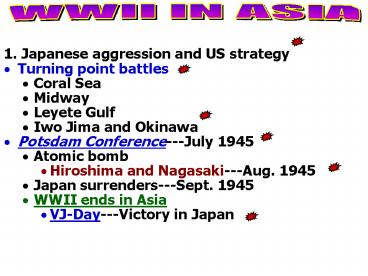1. Japanese aggression and US strategy - PowerPoint PPT Presentation
1 / 17
Title:
1. Japanese aggression and US strategy
Description:
1. Japanese aggression and US strategy Turning point battles Coral Sea Midway Leyete Gulf Iwo Jima and Okinawa Potsdam Conference---July 1945 Atomic bomb – PowerPoint PPT presentation
Number of Views:135
Avg rating:3.0/5.0
Title: 1. Japanese aggression and US strategy
1
WWII IN ASIA
- 1. Japanese aggression and US strategy
- Turning point battles
- Coral Sea
- Midway
- Leyete Gulf
- Iwo Jima and Okinawa
- Potsdam Conference---July 1945
- Atomic bomb
- Hiroshima and Nagasaki---Aug. 1945
- Japan surrenders---Sept. 1945
- WWII ends in Asia
- VJ-Day---Victory in Japan
2
map/japan
- JAPANESE EXPANSION
- Dec. 7, 1941, Japan attacks Pearl Harbor
- US declares war on Japan.
- 1942
- Philippines
- Bataan Death March
3
Bataan Death March April, 1942
- Approximately 80,000 US and Filipino troops
12,000 Americans surrendered to the Japanese
and were forced to march 60 miles to Camp
ODonnell. - Several thousand died along the way from
atrocities committed by the Japanese soldiers.
4
map/japan
- JAPANESE EXPANSION
- Dec. 7, 1941, Japan attacks Pearl Harbor
- US declares war on Japan.
- 1942
- Philippines
- Bataan Death March
"Island hopping" or "leap frogging" all the way
to Japan. Difficult strategy of re-taking
islands Japan had under their control...
- Guam
- Malaya
- New Guinea
- Threatening Australia and Hawaii
5
WWII Military Leaders
WWII MILITARY LEADERS
- West Point Graduate
- Commanding general of troops in the Philippines
- Forced off the Philippines in 1942--- I shall
return - 1944, Battle of Leyete Gulf---- I have returned
to re-take the Philippines. - Supreme Allied Commander in the South Pacific
General Douglas MacArthur
6
map/japan
- TURNING POINT BATTLES
- 1942
- Coral Sea
- Midway
- Midway virtually destroyed Japanese Navy.
- 1943
- Continued island hopping strategy
7
The Doolittle Raid
- After Pearl Harbor, FDR wanted a morale booster.
- He wanted to bomb Tokyo but aircraft carriers
could not get close enough. - Plan B-25s (which could launch off carriers)
would bomb Tokyo and land in China. - Lt. Col. James Doolittle was in command of this
operation. - On April 18th, 1942 bombs fell on Tokyo, which
led to a change in strategy among the Japanese
leaders.
Lt. Col. James Doolittle
B-25s off to Tokyo
8
Change in Japanese Strategy
- Japanese leaders were rattled by the raidsbombs
might have killed the emperor!! - The American fleet, they decided, had to be
destroyed! - They wanted to cut off their supply lines to
Australia. - They decided to attack Midway Islandthe last
American base west of Pearl Harbor.
Bombs falling on Tokyo.
9
The Battle of Midway
- Code-breakers heard the plan.
- At the Battle of Coral Sea, the Yorktown and the
Lexington fended off a Japanese attack on New
Guinea and preserved Australia. - Code-breakers learned of plan to attack Midway
- Admiral Nimitz used this as an opportunity to
ambush the Japanese fleet. - Japanese plans were hit with antiaircraft fire,
shooting down 38 planes. - Japan lost 100 pilots which hurt their Air War.
- American planes caught carriers by surprisetheir
fuel, bombs, and aircraft were exposed. - Four Japanese carriers were sunk, destroying the
heart of the navy. - This hit the Japanese hardit halted Japanese
expansion in the Pacific.
Fighting at the Battle of Midway
Badly damaged Yorktown
10
Battle of Midway IslandJune 4-6, 1942
11
Battle of the Coral SeaJune 4-6, 1942
12
Gen. MacArthur Returns to the Philippines!
1944
13
Japanese Kamikaze PlanesThe Scourge of the
South Pacific
Kamikaze Pilots
- The last 2 years of the war, the Japanese
resorted to suicidal bombers or Kamikaze
bombers to destroy the American Navy. - Approximately 2,800 Kamikaze attackers sunk 34
Navy ships, damaged 368 others, killed 4,900
sailors, and wounded over 4,800.
14
map/japan
- TURNING POINT BATTLES
- 1944
- Battle of Leyete Gulf, recaptured the Philippines
- 1945
- Iwo Jima and Okinawa
- Put the US 500 miles from mainland Japan
- Began bombing mainland Japan
15
US Marines on Mt. Surbachi,Iwo Jima Feb. 19,
1945
16
potsdam
POTSDAM CONFERENCE
- Big Three
- Churchill, Truman and Stalin meet in Potsdam,
Germany in July 1945. - Truman informed of successful test of bomb.
- Demanded unconditional surrender from Japanese or
a new weapon would be used.
17
potsdam
POTSDAM CONFERENCE
- Some suggest that Truman was warning Stalin.
- If he didnt follow through with the decisions at
Yalta, it could happen to the Soviet Union.































